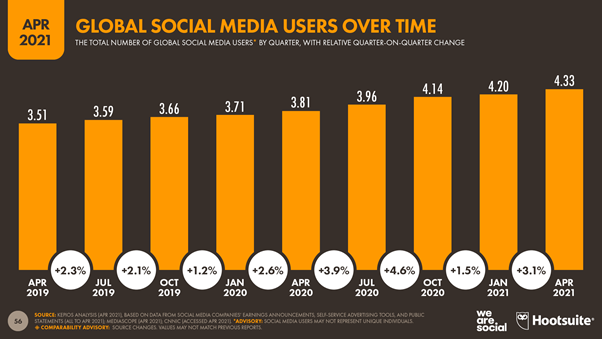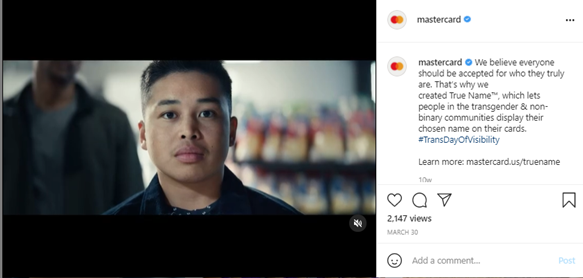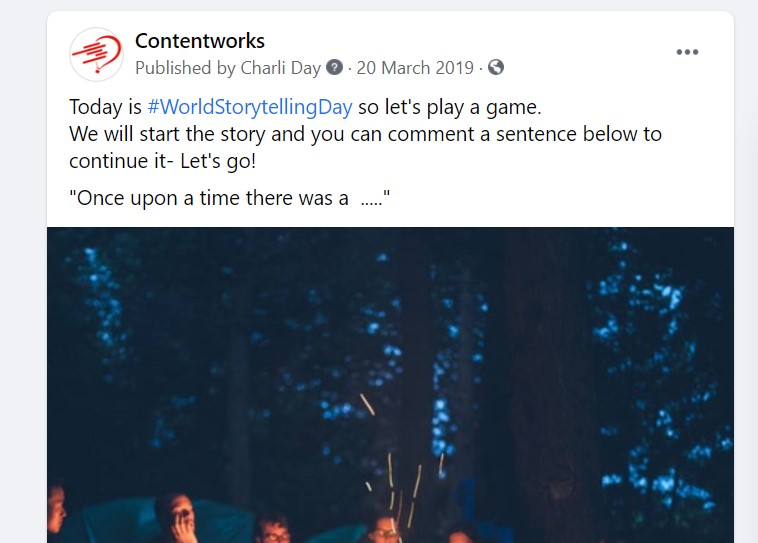A great caption can make all the difference to your post’s engagement and subsequent conversions. In this article I’m delving into the importance of treating your social media caption as an integral component of your content. Plus we’re going to look at some examples of brands making it happen. Let’s talk about writing social media captions that increase engagement.
What Good Social Media Captions Do For A Brand
The use of social media has been seeing growth pretty consistently since its infancy. When global lockdowns began and people were isolated, social media use saw an even greater increase.

As you can see above, with almost everyone working from home, only essential shops open, and pub doors strictly shut, people turned to social media to occupy their time and keep in contact with friends and loved ones. What’s more, social media is expected to continue seeing growth and reach 4.41 billion users by 2025.
With supply not wanting to be outstripped by demand, we’ve also been seeing an increase in social media marketing. In fact, according to Nielsen’s 2021 report, approximately 70% of marketers plan to increase their spend on social media marketing in the next year. With more people spending time on social media, there’s more opportunity for marketers. The only problem is the increased competition which is where great captions come in. Stephanie Cartin, co-CEO at Socialfly shares
‘Strong imagery is what stops users in their feed. However, captions are what drive engagement.’
‘It’s like the cherry on top,’ says US influencer Mariko Dennis. ‘[Captions let your audience] learn more about who you are and what your thought process is like, rather than just see your physical self.’
So, no matter your goals on social media, captions can drive engagement, and in turn, sales.
What Makes A Great Caption?
The basics first. Then we’ll share some examples from the brands getting captions right.
#1 Spelling and grammar
Even on social media where writing conventions are not always strictly adhered to, sound spelling and grammar, particularly in marketing, are still crucial. Always proofread your captions (more than once!) and use a free tool like Grammarly to catch things like accidentally omitted words. I don’t use Grammarly myself but if you’re not a writer, you might find it helpful.
#2 Considering your caption’s length
The character limit of captions differs hugely across platforms. For standard posts, you’re allowed the following number of characters:
- Tiktok – 140
- Twitter – 280
- LinkedIn Company Update – 700
- Instagram – 2,200
- Facebook – 63,206
If you’re crafting a cross-platform campaign, you’ll need to either write captions that can be accommodated by every platform’s character limit or individually tailor each caption. There’s plenty of debate as to the preferred caption length; some argue the shorter the caption, the greater the engagement – with one study finding that captions with ten words or less see the best results.
However, on the flip side, it’s been common knowledge for a number of years that long-form content – such as lengthy articles, blog posts, and reports – positively impact engagement. So there’s no reason this can’t translate to social media posts. That’s not to say your caption should be 3000+ words, but don’t be fooled into thinking every caption you write needs to be single-digit length.
Gen Z has an attention span of around 8 seconds and a disdain for traditional forms of marketing. This means marketers need to get savvier with their approach. Storytelling as a form of marketing has really gained traction in the past decade or so.
Learn more about what effective storytelling can do for your brand.
#3 Adding personality
Write captions that sound like they were written by a human. Consumers nowadays want their brands to address them with a personal tone, not like a robot. A recent poll on LinkedIn found that the majority of people think LinkedIn profiles written in 3rd person sound ‘strange’ and ‘unfriendly.’ Yet, each week I still encounter brands who insist on 3rd person in their social media posts. The general misconception is that it makes them sound professional, reputable and esteemed. I generally disagree.
Typically, you’ll want to write your captions in 1st person rather than 3rd person, like, ‘We’re hosting a free virtual workshop. Join us at 2 pm tomorrow.’ instead of ‘Contentworks invites you to attend our free virtual workshop at 2 pm tomorrow.’
#4 Writing with intent
What do you want to achieve with your caption? Examples could include:
Trying to sell a product or service
If this is the case, you’ll want to include a link and a description of the product that includes frequently asked questions like available sizes, colours, delivery info, etc. Word of warning though: with Instagram captions you cannot include a clickable link in the caption, so doing so may give the impression you don’t know what you’re doing.

Surprisingly, even big brands like Mastercard (above) sometimes get this wrong. Instead, what you can do is write ‘Link in bio’ and include your clickable link there. So that your bio isn’t filled with numerous links to landing pages, once engagement drops off from that specific post, you could edit the caption with something like ‘More info on our website – link in bio’ to direct traffic to your homepage where they can then search or navigate to the page they need. Or, you can do what a number of brands do and tell fans exactly what to search for. for example – Search summer sun flipflops on our site now!
Getting an audience to take a specific action
If this is your desired outcome, include explicit instructions on what you want to happen, for example:
- Follow the link in the description
- Enter your details before [date] to be in with a chance to win
- Winners will be announced on [date and time]
Getting more brand awareness
If your goal is increased brand awareness, your caption should include something memorable and representative of your brand such as your mission or achievements. You’ll also want to write a caption that promotes sharing . This can be achieved by a prize draw where participants must share your post to be eligible.
Comments and likes
If you want your post to get a high level of engagement, pose a question that encourages discussion – an open-ended question will always garner better engagement than a closed, yes/no question. Remember though, too many questions will make you sound like the Riddler and you won’t get any engagement at all. For example “Did you watch the latest episode of X show? What did you think? What will happen next? That just seems like way too much work for a fan.
Competitions where entrees needed to ‘tag a friend’ to enter are great. You could also share a relatable meme with the caption ‘Tag a friend who does this.’ Or, try letting your audience finish the caption for you. If successful, this can be a lot of fun – see an example from us here.

#5 Not saving the best for last
Across all platforms, you’ll want to include the most critical info first. This is due to a combination of wanting to grab attention but also avoiding important text being hidden by the ‘See more’ button. For this reason, a CTA should be included near the beginning of your text. Hashtags still work fine at the bottom of a post, so definitely save those for last along with any @mentions.
#6 Hashtags done right
Did you know that Instagram posts with one hashtag or more get 29% more interactions than posts with none? The role of the hashtag is basically to give you organic engagement you would otherwise not see by users searching for that specific tag.
For Instagram, where you can bury your hashtags beneath the ‘[see] more’ button, there’s not too much harm in including the maximum number allowed (30), especially if you’re a smaller brand that’s counting on engagement via hashtags. If your brand is opting for a more serious brand voice, though, too many hashtags can run the risk of looking a bit spammy.
For Twitter, where your hashtags will be on display for all to see, definitely keep your use conservative. The sweet spot for hashtags on Twitter is one to two, with engagement dropping off when more are used. Research which relevant hashtags are the most popular for the best chance of a wide reach. You can do this while writing them out since Instagram will make suggestions of popular hashtags and tell you how much they’ve been used.
How can I hide my hashtags?
There’s a subtle art to this. If your caption is short enough, hashtags you place at the bottom will be visible without users needing to press the ‘More’ button, which (especially if you’re using a lot) can look a little tacky and try-hard. Even if your caption is longer, and users need to press the button to read the entirety, you may still wish to hide your hashtags in the depths of your caption.
To hide your hashtags, there’s a couple of methods. The first is to use full stops (.) – place one on each line for five lines below your caption, then place your hashtags; this forces your hashtags beneath the ‘More’ button. If you don’t want full stops cluttering up your caption and would prefer blank lines, there are free online tools that can do this for you by inserting hidden characters.
A different method is to forget putting hashtags in your caption altogether and instead put them in a comment on the post. They still do their job but your audience won’t see them on your post unless they go to the comments.
# 7 Using emojis
Concerted use of emojis can add personality to your captions. Even more serious brands from the finance sector are getting in on emojis. Emojis pretty much have the exact same meaning to every person who sees them, making them the perfect tool for transcending generations, cultures, and languages. Additionally, they can add a little fun to your caption and brand voice, as well as grab the attention of scrollers.
Here are some examples of how you can incorporate the emoji craze:
Bullet points
Bullet points are a great way to break up text in your caption but unfortunately, you’re not able to add traditional bullet points on the platform. You could use asterisks (*) or another character for a similar effect, but emojis do the same job, if not better, and definitely add a little pizzazz to your caption.
Be aware of accessibility in your captions
Text-to-speech softwares created by the likes of WellSaid Labs or similar companies, can read all elements of a web page or social media posts – including emojis. So, imagine how difficult it would be to interpret a page where every other word is followed by an emoji. Or if a word is partially formed from an emoji. For this reason, it’s a good idea to avoid long strings of emojis to make content more accessible to people with visual impairments.
And what about hashtags? Don’t forget to capitalise the first letter of every new word. This is called CamelCase and helps screen reading software detect multiple words. If you don’t do this, multiple words from a single hashtag will be read as if they’re one long word.
Lastly, avoid fancy fonts and mixed colours in your captions. These are difficult for visually impaired people or text to speech software to pick up.

#8 Tagging
We’ve already talked about the power of the hashtag, but other forms of tagging on social media exist too. On Instagram you can use:
- Hashtags
- Mentions/account tags
- Location tags
- Product tags
Always tag any other brands or organisations that you partner with. It’s a courtesy to them (meaning they’ll likely return the favour) but also means their audience can see your post in that account’s ‘tags’. You can tag the photo directly or mention the account in the bio (or both) as Lloyds has done below. Similarly, if a fan has uploaded a video or pic of your product and you want to share it, send them some love while you do.
Ready To Create Great Captions?
Social media captions can make or break your posts. If you’ve got great designs and you’re not factoring in great content, you’re missing out. So, a quick recap:
- Create Captions With Intention.
- Encourage Conversations
- Tag, Mention and Thank
- Use Hashtags and Emojis but use them right!
- Include A Call To Action but not always – don’t be “that brand”
- Add Value and be useful to fans
- Keep It Real
What are your top tips for writing great social media captions? Tweet me @Charli_Says and get in contact for great social media content marketing.
